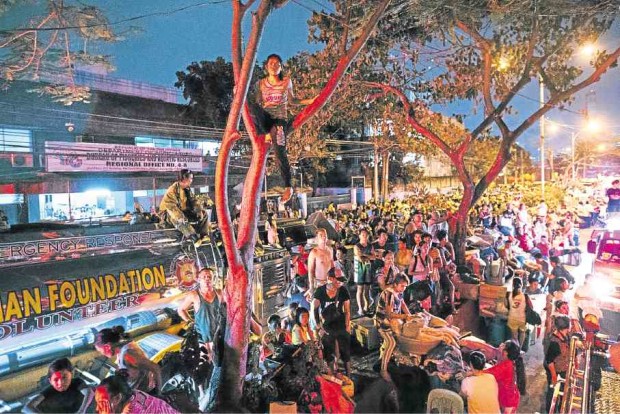‘We have nowhere to go’
The day after a six-hour fire left around 1,000 families homeless on NIA Road in Quezon City, 4-year-old Jasper was inconsolable.
His mother, Julie Amor, told the Inquirer on Wednesday that her youngest child had been crying all day over his puppy, Giyomi, who was killed in the blaze.
Amor, 32, makes a living gathering and selling scraps near the area. She and her family were staying at the second floor of one of the burnt houses, paying P1,400 a month for rent.
“We will not leave this place because it is near where we work,” she told the Inquirer. “We have nowhere to go so we will just welcome the new year under the tree at the corner or on the roadside. At least, we are together.”
Around 500 houses were destroyed in the blaze that hit on Tuesday night a portion of NIA Road which is home to a huge community of informal settlers.
According to the Quezon City Fire District, it was this year’s biggest fire in terms of alarm status, reaching Task Force Delta in just about an hour. Delta is the third from the last of the fire alarm levels, the highest being general alarm.
In a report submitted to Senior Supt. Manuel Manuel, district fire marshal, the blaze started at 6:25 p.m. at the second floor of a house owned by Romano Jinayo on NIA Road near the corner of East Avenue.
Quick to spread
It quickly spread to other houses which were made of light and combustible materials. The alarm was raised to Task Force Delta at 7:44 p.m. before the fire was declared under control at 9:58 p.m.
The blaze was finally put out at 12:48 a.m. on Wednesday, more than six hours after it began.
Senior Insp. Joseph del Mundo, investigation and intelligence chief, said that 74 fire trucks from different cities responded to the call for help. Seven ambulances from the fire bureau, local government, Red Cross and volunteers also went to the area.
Road blocks
“We had a difficult time putting out the fire because the pathways were not accessible,” he told the Inquirer.
Del Mundo noted that the area was like a maze with criss-crossing alleys and houses sharing thin walls.
At the height of the fire, explosions were also reported, believed to have been caused by leaking gas tanks exposed to high heat.
Only one casualty was reported: 74-year-old Corazon Teozon who was found inside her house. Del Mundo said the elderly woman may have been asleep when the fire broke out. Three other people sustained minor injuries.
The estimated cost of property lost was placed at P2 million with the cause of the blaze still under investigation.
On Wednesday afternoon, residents were still reeling from the loss of their homes, just a few days shy of the New Year.
Around 300 families were seeking shelter at the covered court of Barangay Pinyahan, where the city government and volunteers were distributing medicine, cooked food and bottled water.
Family intact, belongings lost
Some residents said they were not at home when the fire broke out. One of them was 42-year-old Alma Jarito who has lived in the area for 17 years. Her husband and six children were spared by the fire although they lost all their belongings.
“It’s very painful to lose everything,” she said as she stood in line for clothes being provided by barangay officials. “I think we will welcome the New Year here in the covered court.”
This was not the first time her house burned down, she added. In 2011, a blaze hit the same area. Based on the city fire department’s records, Tuesday night’s fire was the third.
Barangay captain Jesus Lipnica Jr. noted that the land was owned by the National Housing Authority although he added that there have been no moves to relocate the informal settlers.
Still, many residents would rather stay on NIA Road, the area being near to where they work or get their source of livelihood.
When the Inquirer visited the area, some of the fire victims were already building makeshift shelters on NIA Road.
Men and young boys gathered whatever reusable building materials they could from burnt heaps, from scrap metal to galvanized iron sheets.
